One more inoculation
One of the most encouraging trends in the dog-owning community is the increase in attendance at puppy classes. More and more vets are aware of the considerable benefits of well-run puppy classes taught by qualified professional instructors in a safe, sanitary, and controlled environment. Puppy class is frequently, and correctly, touted as a "behavioral vaccine," a proactive way to prevent behavior problems in adult dogs.
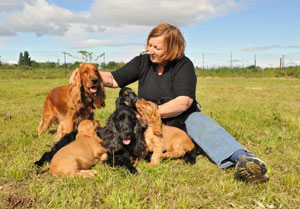
Don't stop there
You've passed puppy class, proudly displaying your graduation diploma in a frame on the living room wall. Pictures of your precious puppy wearing a cap and gown grace your desk, earning exclamations of, "What a smart girl!" and "What a beautiful puppy!" from your envious colleagues. Everything is going beautifully; you are proud of the training accomplishments you and your dog have achieved as a team.
Until one day, when your dog is around six months old, you head out in the woods for your daily walk. For the first time in her life, your puppy, the smartest puppy in the world, blows off the recall signal, running as fast as she can after a deer! Your heart races as you call repeatedly, fearing the worst and hoping for the best. Eventually, your puppy comes back. What happened?
While puppy class can help establish great foundations for training, it is only the beginning of your dog's behavioral and physical development. As your dog ages, new training activities will be required to keep both manners and mind sharp and active. What sorts of training activities are appropriate at various stages in her life.
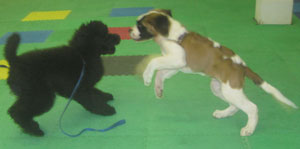
Puppyhood (birth to age five months)
The puppy stage is so full of critical periods of development it's worthy of a separate article. To learn about all the development your puppy will experience during this stage, check out this detailed and informative link.
Puppyhood is a time to focus on socialization primarily. You have your dog's entire life to develop a freestyle routine, a competition-level heel, or a rock-solid down stay. You only have these first few precious months to teach your puppy how to experience the world. It's important for your puppy to learn that people, dogs, and other animals are friends, not foe, and that getting baths, going to the vet or groomer, camping in a tent, hanging out with little kids, and having nails trimmed are not scary, but fun! Puppyhood is a time for building creativity through enrichment activities (like work-to-eat toys) and clicker training (especially shaping).
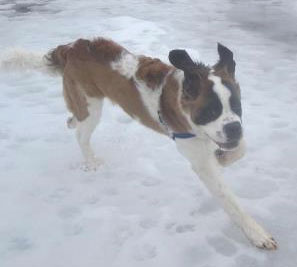
Adolescence (five months to 1-3 years)
Adolescence tends to last a lot longer in larger and giant-breed dogs than it does in their smaller canine cousins. Toy breeds may pass through most of this stage of development by the time they turn one year old. My Saint Bernard, at two years old, is still in the midst of his adolescence and often appears to define the term "terrible twos!"
Adolescence can be a challenging time for dogs and their owners; during this stage is when the majority of pet dogs are relinquished to a shelter or rescue organization. During adolescence, dogs need more physical and mental stimulation than at any other time, and many behavior problems emerge when these needs are not met. Dogs will test their boundaries during this stage, and will find a way to get in trouble if the environment is not carefully managed. Counter surfing, escaping the yard, bolting out the door, digging holes in the yard, barking and lunging at passing people and dogs, and demand barking are a few of the problems that can arrive during the "terrible teen" stage.
Many pet owners hesitate to call puppy class instructors for help with adolescence because they are embarrassed that they still need training assistance. Never feel ashamed to get the help you need! Many trainers have classes geared specifically for adolescent dogs. These classes typically have an extensive focus on impulse control exercises, development of foundation skills like recall and loose-leash walking, and creative ways to provide physical and mental stimulation for an active dog. The classes also deal with the nefarious stage known as "the second fear period," when your adolescent dog may be spooked by things to which the dog had already been socialized during puppyhood.
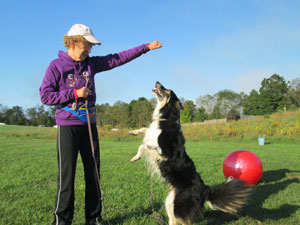
Adult life (post-adolescence/pre-senior)
It's hard to assign a number in years to the front or back end of this stage because of the wide variance in development among individual dogs. Generally, the adult stage starts sooner and lasts longer in smaller dogs. Large and giant-breed dogs reach social and behavioral maturity later than toy breeds, and tend to reach the senior stage earlier, so the period they spend in the adult phase of development is somewhat truncated.
Adulthood is a wonderful period of time to spend with your dog if you've laid appropriate foundation work in the previous stages. If you want to compete in a dog sport, your dog is likely to be ready to do so. If you are considering therapy work, now is the time to prepare for your assessments and new career as a working team, bringing smiles to those who most need them.
The hard work of training has paid off, and you can reap the benefits of a dog that walks politely on a leash, comes when called, and greets guests with four on the floor. If it's a priority for you, adulthood is also the best time to begin allowing your dog measured freedom from the crate when you are not at home—provided that you are happy with his manners when you are at home.
Enjoy! This stage can be everything you've been working toward, everything you envisioned dog ownership to be.
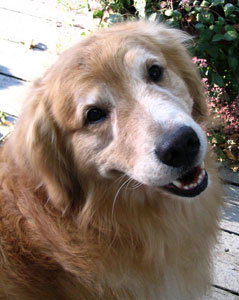
Photo courtesy of Dana Fedman.
Senior citizen (variable)
The golden years are usually characterized by graying muzzles and reduced energy levels. During this stage, it is not uncommon for dogs to become increasingly intolerant of "shenanigans" or rough play with other dogs. Senior dogs are sometimes curmudgeons and may no longer enjoy the rough-and-tumble craziness of the dog park, preferring instead a long walk in a quiet location.
You may find that at this stage your dog begins to experience poor health and needs "palliative" training. Your dog may not see or hear as well as before. If this is the case, you may need to condition new markers and transfer cues so that you can continue to communicate with your dog. Your dog may have a hard time waiting as long for potty breaks, may have to learn to use ramps to get in and out of the snuggle spot on your bed or your SUV, and/or may need to be supported with a towel/sling on the back end to get up stairs safely.
A dog's life—happy at home
One of the questions my clients ask the most is, "When will I be done training my dog?"
As you can see, the answer is never! Just as you parent a child for a lifetime, you must provide lifetime guidance to ensure that your dog thrives in your family. The bond that you formed in that puppy class, and the skills you learned in the "3 Rs" (reading, responding to, and reinforcing your dog) will help you act proactively at the first sign of trouble or strife. When and if you need it, seek assistance from a professional who is part of your training team and cares about you and your dog.
A dog's life has many stages, and most owners are honored to be part of a dog's progression from stage to stage. Each stage is unique and requires understanding, training, and love. Enjoy the discovery of each stage as you and your dog each get older, savoring the surprises of life.
Related Products
|
|
|






Post new comment